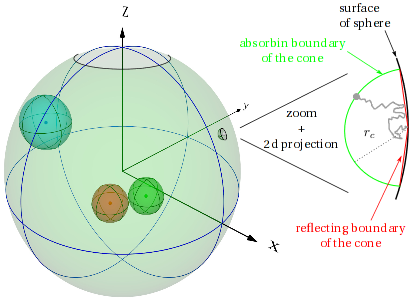AG — Prof. Heiko Rieger — Statistical Physics
Numerical analysis of homogeneous and inhomogeneous intermittent search strategies
Heiko Rieger, Karsten Schwarz, Yannick Schröder

Random search processes for targets that are inhomogeneously distributed in a search domain require spatially inhomogeneous search strategies to find the target as fast as possible. Here we compare systematically the efficiency of homogeneous and inhomogeneous strategies for intermittent search, which alternates stochastically between slow, diffusive motion in which the target can be detected and fast ballistic motion during which targets cannot be detected. We analyze the mean first passage time (MFPT) of homogeneous and inhomogeneous strategies for three paradigmatic search problems: 1) the narrow escape problem, 2) reaction kinetics and 3) the reaction-escape problem. Using families of inhomogeneous strategies, partially motivated by the organization of the cytoskeleton in cells with a centrosome, we show that inhomogeneous strategies are almost always more efficient than homogeneous ones.
The transition rate between the diffusive and the ballistic mode (and back) together with the probability distribution of directions for the ballistic motion defines a search strategy. If these transition rates and/or probability distributions depend on the spatial coordinates within the search domain it is a spatially inhomogeneous search strategy, if both are constant, it is a homogeneous one.
1) In the narrow escape problem, the searcher looks for a target, which is always located somewhere on the boundary of the search domain. Consequently the target position is always inhomogeneously distributed within the search domain. Thus, for the narrow escape problem the MFPTs of inhomogeneous search strategies, which keep the particle mostly close to the boundary of the search domain, are much smaller than the MFPT of the optimal homogeneous strategy.
2) For the reaction kinetics, we study search strategies for an immobile target located within a sphere. In the case of a homogeneous search, the optimal strategies is almost not influenced by the distribution of the target position. In the case of a small area where the immobile target is predominantly placed, the studies of inhomogeneous strategies is very interesting, as the best strategy in not obvious anymore. On the on hand, the searcher should be prevalent in the surrounding of this area. On the other hand, the searcher can't stay there exclusively, as the target might be somewhere else with a non vanishing probability.
3) In the reaction-escape problem, the searcher first needs to find a mobile target before it can escape through a narrow area on the boundary. This is an interesting problem, as the best strategy must be efficient for the reaction- and for the escape problem. In order to study the influence of each partial problem on the overall strategy, we study different setups where each partial problem is differently strong pronounced via the chosen particle-particle reaction distance and the size of the narrow escape area.
| Numerical analysis of homogeneous and inhomogeneous intermittent search strategies |
|
| Phys. Rev E. 94, 042133 (2016) | [pdf], [arXiv] |
Legal notice (Impressum) Privacy policy



